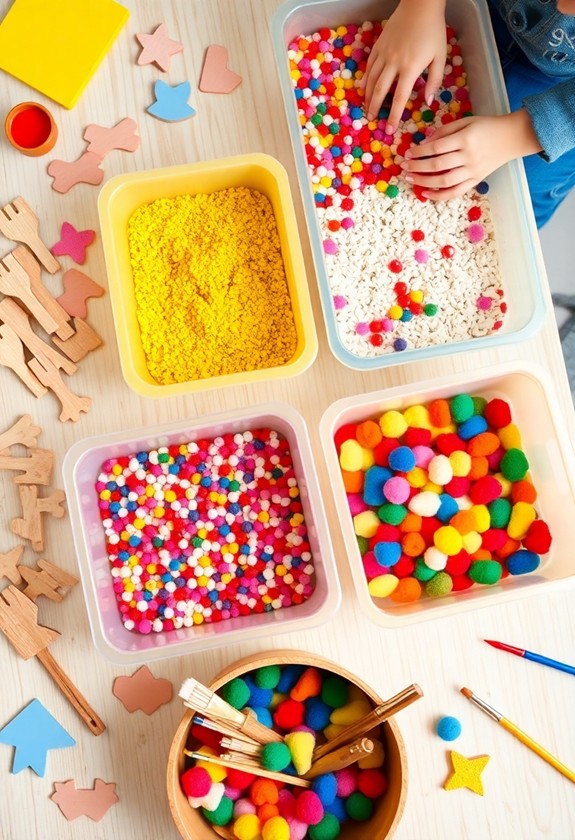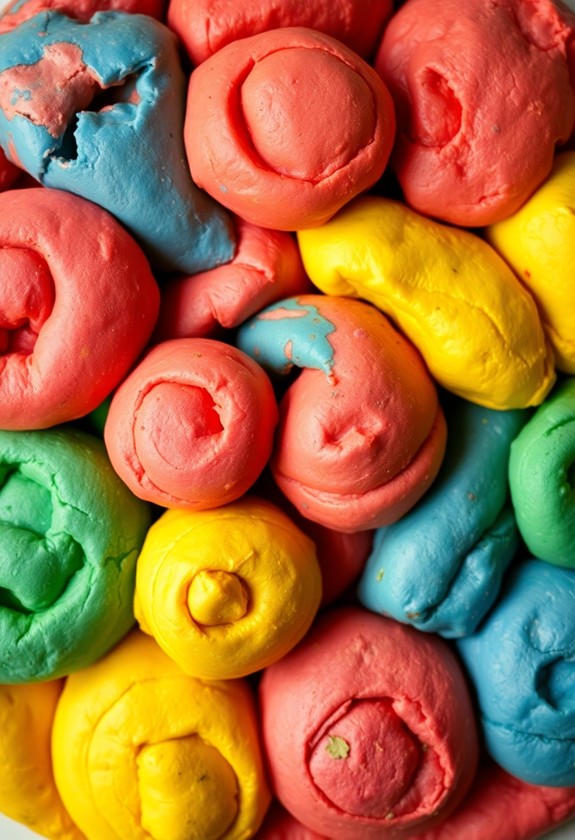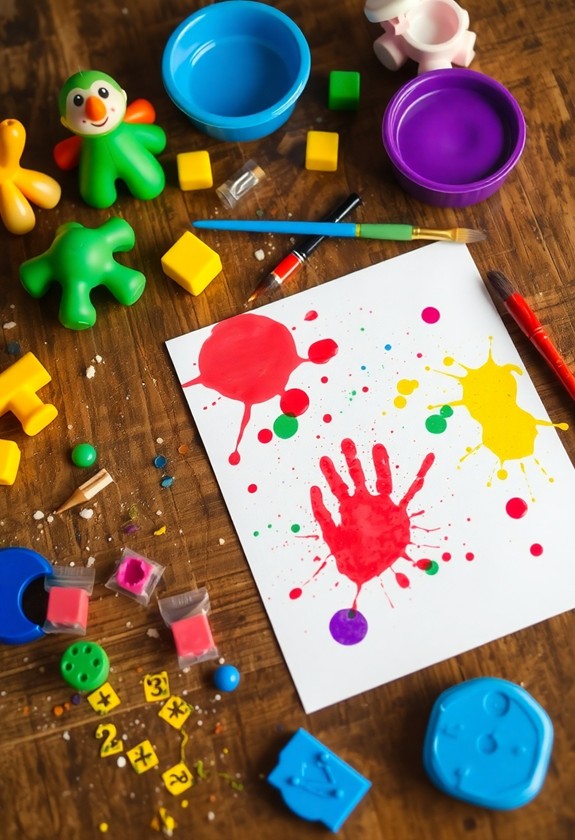Release your toddler's creativity with these 7 amazing Montessori sensory art activities! Let them squish and smear textured paints, create nature collages from outdoor treasures, or sculpt with scented playdough. Watch as they pour colorful rice to make sand art masterpieces, or finger paint with yummy edible ingredients. Set up exciting sensory bins filled with art materials, or investigate textures through rubbing techniques. These hands-on activities engage multiple senses, develop fine motor skills, and spark imagination. Your little one will have a blast experimenting with colors, textures, and materials as they learn about their world. Get ready for some messy, fun-filled artistic adventures!
Creative Highlights
- Textured paint exploration combines vibrant colors with tactile experiences to engage multiple senses and enhance fine motor skills.
- Nature collage creation encourages outdoor exploration and creativity while fostering a connection with the environment.
- Scented playdough sculpting incorporates olfactory stimulation alongside tactile play, promoting sensory awareness and creativity.
- Colored rice sand art offers a safe, vibrant medium for toddlers to explore textures and colors through pouring and scooping.
- Finger painting with edibles provides a tasty, non-toxic alternative that engages multiple senses and encourages artistic expression.
Textured Paint Exploration
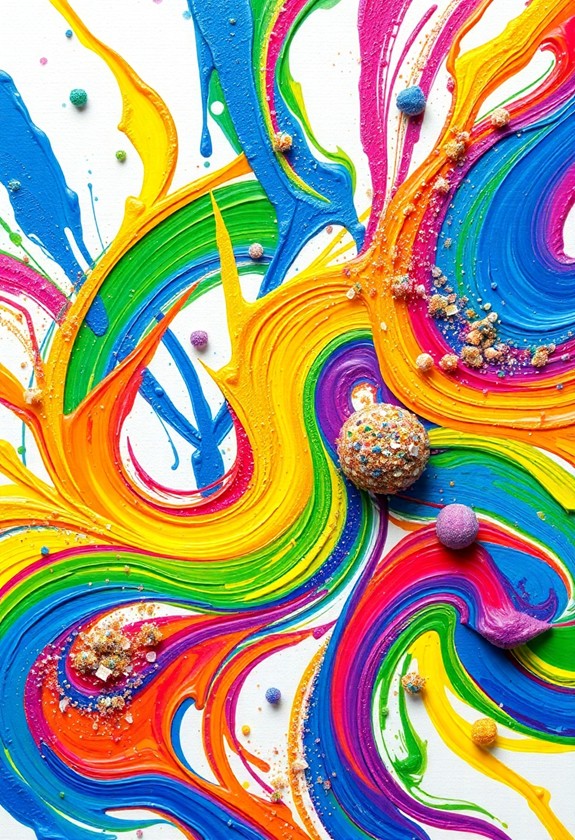
Though traditional painting is fun, textured paint exploration takes the sensory experience to a new level. Your toddler will love squishing, smearing, and creating with these tactile paints! Consider using washable finger paints for easy cleanup and brilliant colors. These paints are designed to be safe and non-toxic, perfect for curious little hands.
Here's how to get started:
- Gather materials:
- Washable tempera paint
- Cornstarch, sand, or salt
- Mixing bowls and spoons
- Cornstarch for a silky feel
- Sand for a gritty texture
- Salt for sparkly crystals
Let your little artist loose on large paper or a smooth surface. Watch as they uncover new sensations and create unique masterpieces! The best part? It's a feast for the senses and a workout for those fine motor skills. Get ready for giggles, messy hands, and loads of learning!
Nature Collage Creation
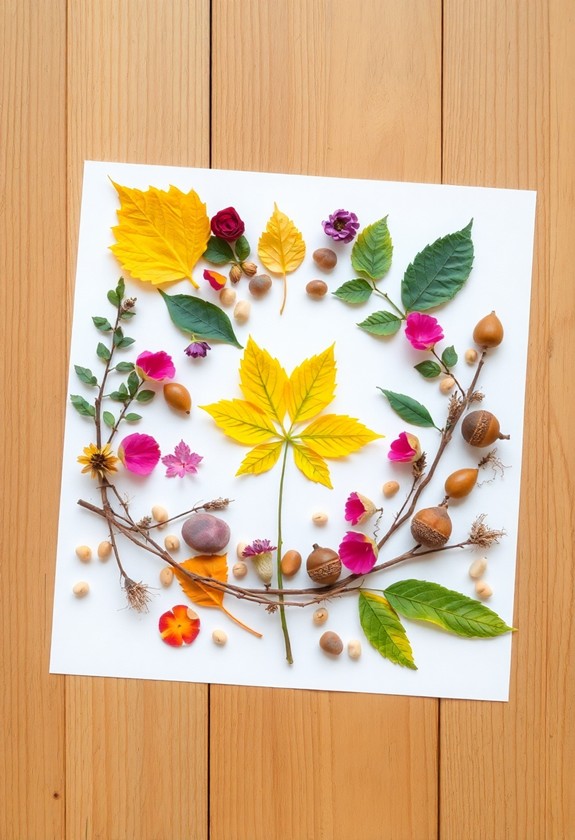
Three simple materials form the foundation of this delightful Montessori activity: nature, glue, and paper. It's time to commence on a sensory adventure with your little one! First, head outdoors for a nature walk. Encourage your toddler to collect leaves, flowers, and small twigs – it's a treasure hunt! This activity not only enhances fine motor skills but also nurtures a deep connection with nature, promoting environmental awareness from an early age.
Back inside, spread out your findings on a table. Now, let the creative juices flow! Help your child arrange the natural elements on paper, creating a unique collage. Assist them in gluing each piece down, but let their imagination lead the way.
This activity is a sensory bonanza! Your toddler will feel different textures, see vivid colors, and even smell the outdoors. Plus, it's a fantastic way to introduce them to nature's wonders. Who knew leaves and twigs could be such fun art supplies?
Scented Playdough Sculpting
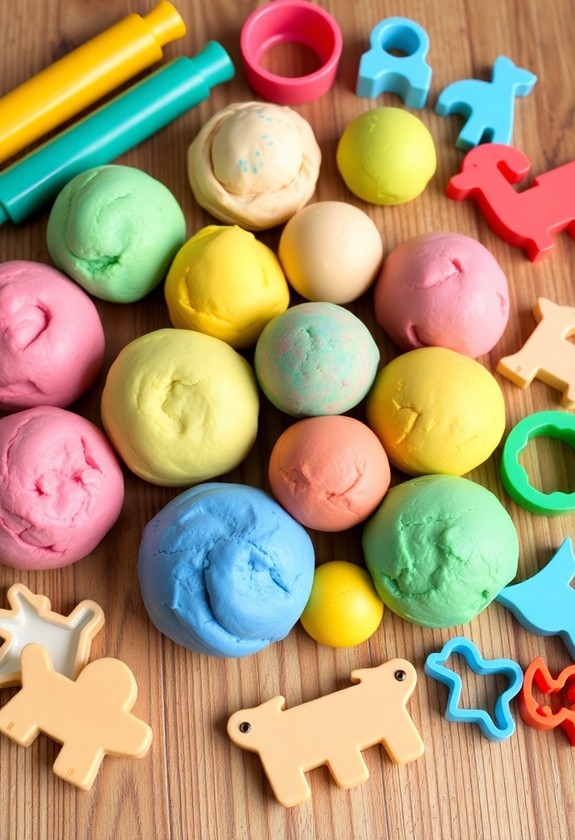
Why not engage your toddler's sense of smell along with touch? Scented playdough sculpting is a fantastic way to do just that! This multi-sensory experience aids in memory retention and information processing, essential for early childhood development. You'll love watching your little one's eyes light up as they squish, mold, and sniff their aromatic creations.
Here's how to get started:
- Mix up a batch of homemade playdough
- Add natural scents like vanilla, lavender, or cinnamon
- Provide safe tools: rolling pins, cookie cutters, plastic knives
Let your child's imagination run wild! They might create:
- A "cinnamon stick" log cabin
- A "vanilla ice cream" cone
- A "lavender flower" garden
As they play, ask questions like, "What does it smell like?" or "Can you make something yummy?" This activity isn't just fun – it's helping your toddler develop fine motor skills and sensory awareness. So, get ready for some scent-sational sculpting!
Colored Rice Sand Art
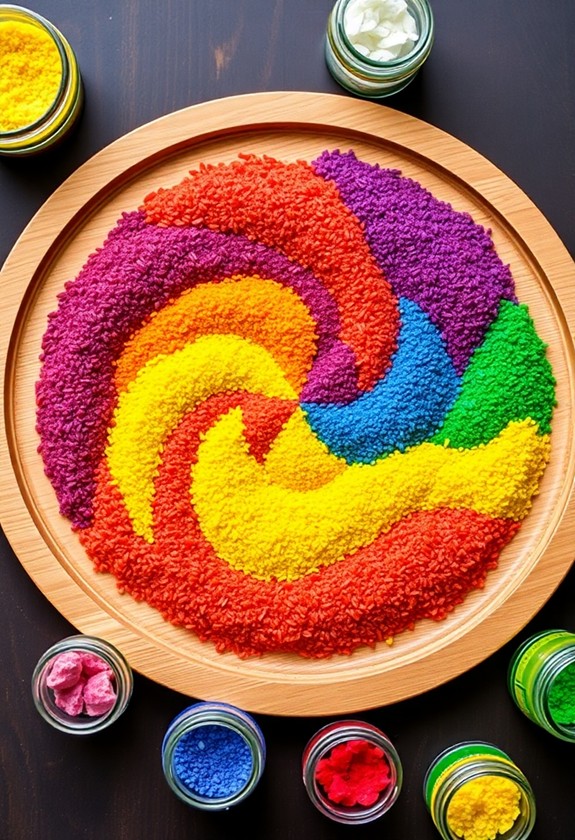
From scented playdough, we now move to a lively, textural experience with colored rice sand art. Get ready for a rainbow of fun! This activity is a feast for the eyes and fingers. It's furthermore an excellent way to promote fine motor skills and creativity in toddlers. Here's what you'll need:
- Uncooked rice
- Food coloring
- Zip-top bags
- Shallow trays or containers
To create your colorful canvas:
- Pour rice into separate bags
- Add a few drops of food coloring to each
- Seal and shake, shake, shake!
- Spread on a tray to dry
Now the real magic begins! Let your little one pour, scoop, and sprinkle the rice to create dazzling designs. They'll love the way it feels running through their fingers. Encourage them to make patterns, scenery, or abstract masterpieces. It's a "rice" way to investigate colors, textures, and creativity!
Finger Painting With Edibles
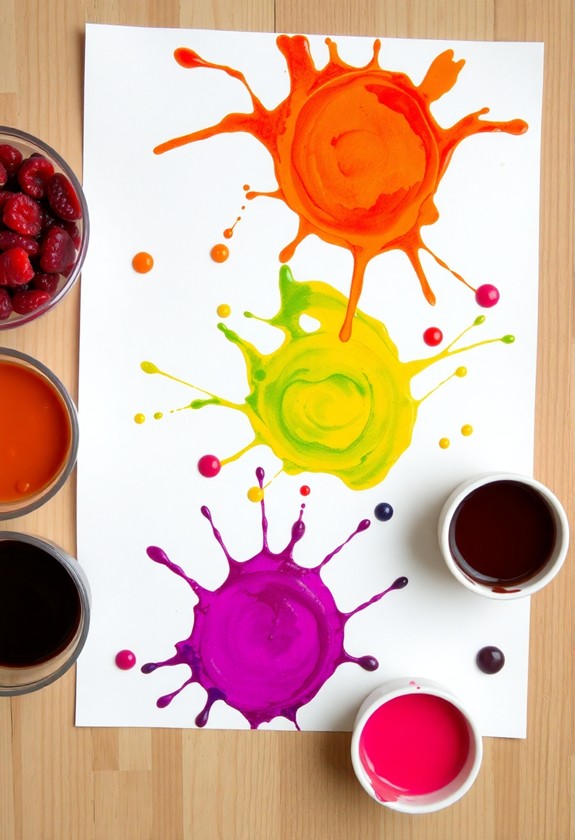
Toddlers' natural curiosity and love for messy play make finger painting an ideal Montessori sensory art activity. But why stop at regular paint? Let's get creative with edible options! You'll love watching your little one investigate textures and tastes as they create masterpieces. Non-toxic alternatives made from common kitchen ingredients offer safe and washable components, ensuring easy cleanup after your art sessions.
Here are some yummy, safe finger paints to try:
- Yogurt + food coloring
- Pudding in various flavors
- Mashed berries
- Applesauce + spices
Set up a fun painting station with:
- Large paper or a smooth tray
- Small bowls of edible "paints"
- Smocks (it'll get messy!)
Encourage your tot to squish, spread, and swirl the paints. They'll giggle with glee as they make colorful designs – and maybe sneak a taste or two! This activity isn't just artsy; it's a feast for the senses!
Sensory Bin Art Adventures
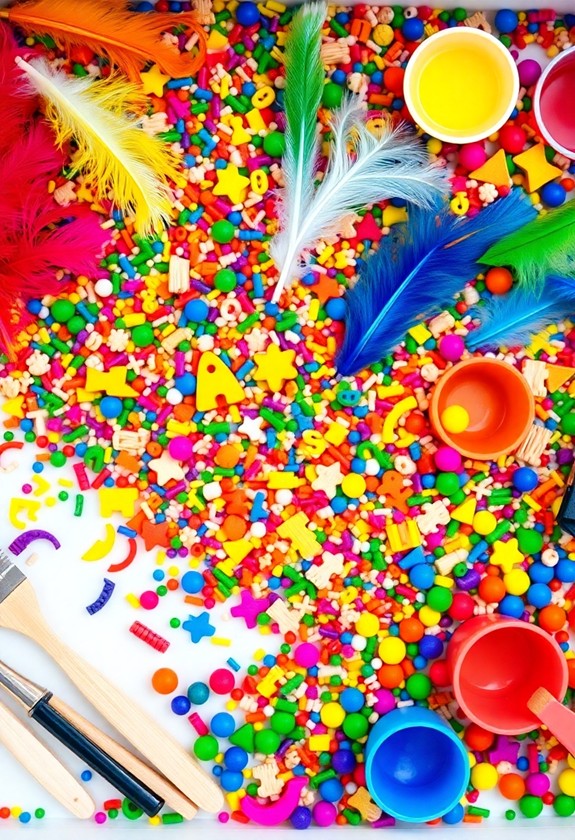
Sensory bins offer a wealth of artistic possibilities for toddlers. They're like mini art studios, packed with textures and materials just waiting to be investigated! Your little one will love getting their hands dirty during the creation of masterpieces. But wait, there's more! Sensory bins aren't just fun – they're fantastic for developing fine motor skills and creativity.
Ready to plunge into it? Here are four awesome sensory bin art ideas:
- Rainbow rice painting
- Colored pasta necklace making
- Sand and seashell mosaics
- Pom-pom and pipe cleaner sculptures
To set up, simply fill a shallow bin with your chosen materials. Add tools like scoops, tongs, and brushes. Then, watch as your toddler's imagination runs wild! They'll squish, squash, and create to their heart's content. Remember, it's all about the process, not the product. So sit back and enjoy the messy, marvelous fun!
Texture Rubbing Masterpieces
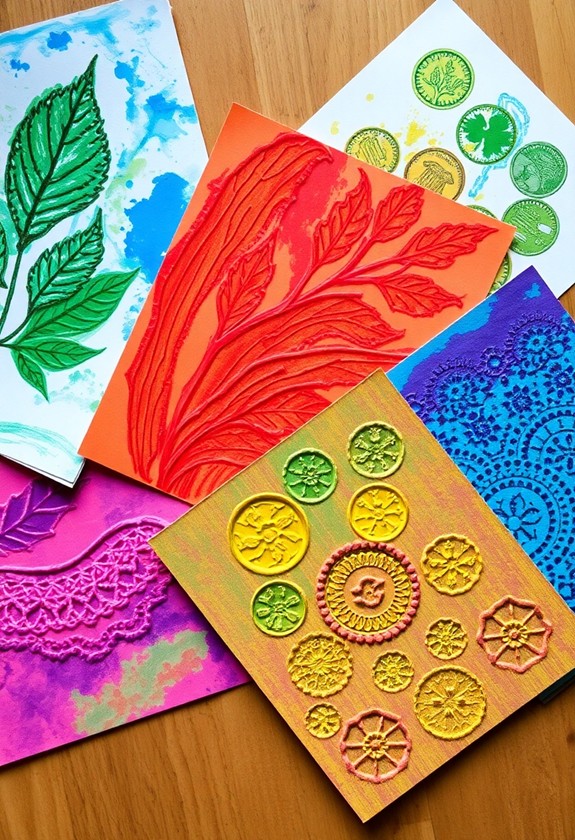
As sensory bins offer endless artistic possibilities, texture rubbing provides a unique tactile experience for toddlers. It's time to investigate the world of texture through art! You'll need:
- Crayons or colored pencils
- Paper
- Various textured surfaces
Here's how to create texture rubbing masterpieces:
- Collect textured items (leaves, coins, sandpaper)
- Place paper over the textured surface
- Rub crayon or pencil over the paper
Watch as patterns emerge like magic! Your little one will be amazed at the "rubbings" they create. This activity isn't just fun, it's a sensory sensation! It helps develop fine motor skills and introduces concepts of cause and effect. Plus, it's a great way to discuss textures: smooth, rough, bumpy. Get ready for some rubbing and learning – it's time to make some textural treasures!
Curious Little Questions
At What Age Can Toddlers Safely Engage in Montessori Sensory Art Activities?
You can start, you can investigate, you can create! Toddlers as young as 18 months can safely enjoy Montessori sensory art activities. But wait, there's more! Even younger babies can participate with close supervision. As your little one grows, so does their artistic adventure:
- 12-18 months: Simple finger painting
- 18-24 months: Play dough and sensory bins
- 2-3 years: Collages and basic drawing
How Can Parents Adapt These Activities for Children With Sensory Sensitivities?
You can easily adapt sensory activities for kids with sensitivities! Here's how:
- Start small: Introduce new textures gradually
- Give choices: Let them pick materials they're comfortable with
- Use tools: Offer brushes or gloves for hands-off exploration
- Create a calm space: Reduce noise and bright lights
- Respect boundaries: Don't force participation
- Adjust intensity: Dilute scents or soften sounds
- Be patient: Let them progress at their own pace
What Are the Best Ways to Clean up After Messy Sensory Art Projects?
Did you know that the average toddler creates about 730 messes a year? That's a lot of clean-up! But don't worry, cleaning up after messy sensory art projects can be a breeze. Here are some top tips:
- Use washable materials
- Lay down plastic tablecloths or newspapers
- Keep wet wipes handy
- Make cleanup a fun game
- Use a dustpan and brush for dry messes
- Soak paintbrushes in warm, soapy water
How Often Should Parents Rotate or Change Sensory Art Materials and Activities?
Hey there, art-loving parents! You've got a great question about rotating sensory materials. Here's the scoop: Change things up every 1-2 weeks! Why? It keeps your little ones excited and engaged. But don't toss everything at once! Gradually swap out materials to maintain some familiarity. And remember, if your kiddo is super into something, let it stick around longer. The key is to watch their interest levels and adjust accordingly. Keep it fresh, keep it fun, and watch those creative juices flow!
Can Montessori Sensory Art Activities Benefit Children With Developmental Delays or Disabilities?
Like a butterfly emerging from its cocoon, children with developmental delays or disabilities can blossom through Montessori sensory art activities. You'll be amazed at how these hands-on experiences can:
- Boost fine motor skills
- Improve sensory processing
- Improve communication
These activities are like magic wands, transforming challenges into opportunities! Your child will love discovering textures, colors, and shapes. Plus, it's a fantastic way to bond and have fun together. So, get ready to release your little one's creativity and watch them soar!

